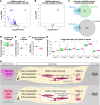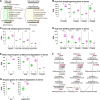Growth phase diets diminish histone acetyltransferase Gcn5 function and shorten lifespan of Drosophila males
- PMID: 40640422
- PMCID: PMC12332192
- DOI: 10.1038/s44319-025-00503-8
Growth phase diets diminish histone acetyltransferase Gcn5 function and shorten lifespan of Drosophila males
Abstract
The nutritional environment in early life, referred to as the nutrition history, exerts far-reaching health effects beyond the developmental stage. Here, with Drosophila melanogaster as a model, we fed larvae on diets consisting of a variety of yeast mutants and explored the resulting histories that impacted adult lifespan. A larval diet comprised of yeast nat3 KO shortened the lifespan of male adults; and remarkably, this diet diminished the function of histone acetyltransferase Gcn5 in larvae. Concordantly, perturbation of Gcn5-mediated gene regulation in the larval whole body or neurons significantly contributed to the earlier death of adults. The nat3 KO diet is much more abundant in long-chain fatty acids and branched-chain amino acids (BCAAs) than the control yeast diet. Supplementing the control diet with a combination of oleic acid, valine, and acetic acid recapitulated the effects of the nat3 KO diet on the larval transcriptome and the lifespan of males. Our findings strongly suggest a causal link between a fatty acids- and BCAA-rich diet in developmental stages and lifespan reduction via the adverse effect on the Gcn5 function.
Keywords: BCAA; DOHaD; Fatty Acid; Gcn5; Histone Acetyltransferase.
© 2025. The Author(s).
Conflict of interest statement
Disclosure and competing interests statement. The authors declare no competing interests.
Figures













References
-
- Adeva-Andany MM, López-Maside L, Donapetry-García C, Fernández-Fernández C, Sixto-Leal C (2017) Enzymes involved in branched-chain amino acid metabolism in humans. Amino Acids 49:1005–1028 - PubMed
-
- Aksnes H, Drazic A, Marie M, Arnesen T (2016) First things first: vital protein marks by N-terminal acetyltransferases. Trends Biochem Sci 41:746–760 - PubMed
MeSH terms
Substances
Grants and funding
- JP18gm1110001/Japan Agency for Medical Research and Development (AMED)
- 21J15091/MEXT | Japan Society for the Promotion of Science (JSPS)
- 17KT0018/MEXT | Japan Society for the Promotion of Science (JSPS)
- 23K27179/MEXT | Japan Society for the Promotion of Science (JSPS)
- 17K15039/MEXT | Japan Society for the Promotion of Science (JSPS)
LinkOut - more resources
Full Text Sources
Molecular Biology Databases
Research Materials

